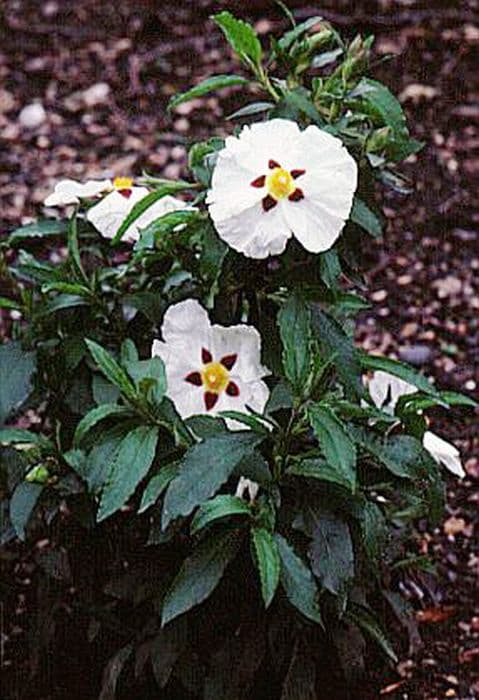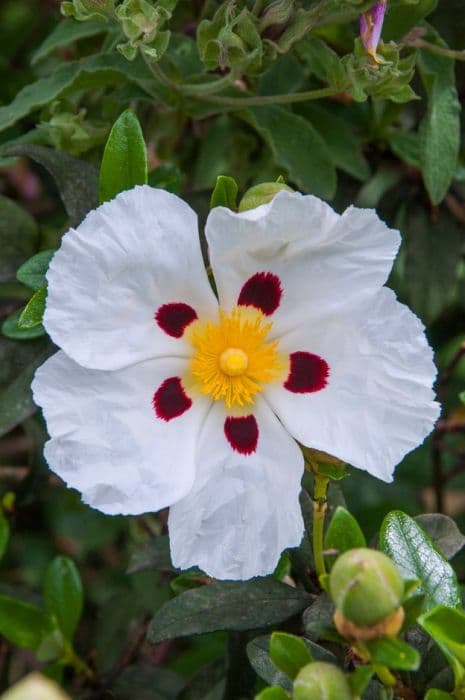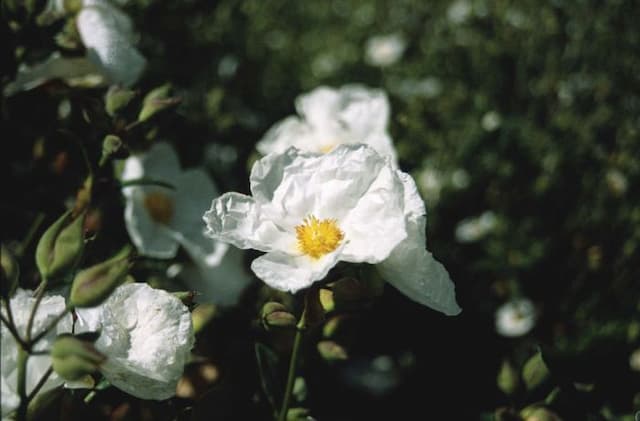Common Rockrose Helianthemum nummularium

ABOUT
The common name for Helianthemum nummularium is common rockrose. This plant is a low-growing, mat-forming evergreen shrub with small, oval-shaped leaves that have a slightly wrinkled texture. The leaves are green, sometimes with a grayish tint, and have a soft, slightly hairy surface which adds to their appeal. During the flowering season, common rockrose produces an abundance of bright, showy flowers. Each flower has five delicate petals which are most commonly a sunny yellow color, though there can be variations depending on the specific variety. These flowers are cup-shaped and look somewhat like miniature roses, which is where the plant gets its name from. It blooms profusely in bright conditions, displaying a vibrant contrast against the foliage. The overall appearance of the common rockrose gives it a charming, rustic look, making it a popular choice for rock gardens and as a ground-cover plant.
About this plant
 Names
NamesFamily
Cistaceae
Synonyms
Common Rockrose, Rock Rose, Sunrose
Common names
Helianthemum chamaecistus, Helianthemum vulgare, Helianthemum oelandicum, Helianthemum apenninum, Cistus helianthemum, Cistus nummularius, Helianthemum nummularium var. grandiflorum, Helianthemum nummularium var. obscurum, Helianthemum obscurum, Helianthemum umbellatum, Helianthemum canum, Tuberaria nummularia, Helianthemum tomentosum.
 Toxicity
ToxicityTo humans
Common rockrose (Helianthemum nummularium) is generally considered non-toxic to humans. There are no significant reports of poisoning or adverse health effects associated with the ingestion of this plant by humans. It's always advisable to exercise caution and avoid consuming plants unless you are certain about their edibility and have confirmed they are safe to ingest.
To pets
Common rockrose (Helianthemum nummularium) is not known to be toxic to pets. It does not appear on lists of plants that are poisonous to dogs, cats, or other domestic animals. However, as with any non-food plant, ingestion in large quantities may cause mild gastrointestinal upset such as vomiting or diarrhea due to the novelty of the plant material in the animal's diet. If you believe your pet has ingested a large amount of this plant and is showing adverse symptoms, consult your veterinarian.
 Characteristics
CharacteristicsLife cycle
Perennials
Foliage type
Evergreen
Color of leaves
Green
Flower color
Yellow
Height
1 foot (0.3 meters)
Spread
2 feet (0.6 meters)
Plant type
Shrub
Hardiness zones
5
Native area
Europe
Benefits
 General Benefits
General Benefits- Ornamental value: The plant, commonly known as rock rose, has bright yellow flowers that add aesthetic appeal to gardens and landscapes.
- Drought tolerance: Rock rose is well-suited to dry, arid environments, making it a great option for water-wise gardening.
- Soil stabilization: Its root system can help prevent soil erosion, especially on slopes and in rocky areas.
- Pollinator attraction: The flowers of rock rose attract bees and other pollinators, supporting local ecosystems.
- Low maintenance: Rock rose typically requires minimal care once established, which can reduce gardening effort and costs.
- Ground cover: With its sprawling habit, rock rose can act as a ground cover to suppress weeds and cover bare spots in the landscape.
- Sunlight resilience: The plant thrives in full sun, making it ideal for sunny spots where other plants might struggle.
 Medical Properties
Medical Properties- Astringent: Helianthemum nummularium is traditionally used for its astringent properties, which can help in tightening and toning tissues.
- Antispasmodic: It is said to possess antispasmodic effects that may help in relieving spasms or cramps, particularly in the digestive system.
- Anti-inflammatory: The plant may have anti-inflammatory agents that can be used to soothe inflammation in various parts of the body.
- Diuretic: Helianthemum nummularium has been used as a diuretic to help increase the passing of urine.
- Vulnerary: It is sometimes applied as a vulnerary to heal wounds, sores, and other skin problems.
- Sedative: There is a belief that it can act as a sedative to help in relieving nervous tension and combat stress.
 Air-purifying Qualities
Air-purifying QualitiesThis plant is not specifically known for air purifying qualities.
 Other Uses
Other Uses- Rock gardens: Rockrose is well-suited for rock gardens due to its ability to thrive in poor soil and its drought-resistant qualities.
- Bonsai: Can be trained as a bonsai due to its small size and attractive flowers.
- Ground cover: Due to its spreading habit, it is effective as a ground cover plant, controlling erosion and supressing weeds in sunny landscapes.
- Butterfly attraction: The flowers of Rockrose attract butterflies, making it a beneficial addition to butterfly gardens.
- Sand dune stabilization: Its root system helps stabilize sandy soils, making it useful for planting in coastal dune restoration projects.
- Photography subject: Its vibrant flowers are often used by photographers as a subject for nature photography.
- Cultural symbols: In some cultures, Rockrose is used symbolically in gardens and floral arrangements to represent survival and resilience.
- Landscape design: Its mat-forming habit and profusion of flowers are used by landscape designers to create visual impact in sunny areas.
- Green roofing: Sometimes utilized in green roof systems due to its low maintenance and ability to withstand harsh rooftop conditions.
- Educational purposes: Often used in educational programs to illustrate plant adaptation to xeric (dry) conditions.
Interesting Facts
 Feng Shui
Feng ShuiThe Rock Rose is not used in Feng Shui practice.
 Zodiac Sign Compitability
Zodiac Sign CompitabilityThe Rock Rose is not used in astrology practice.
 Plant Symbolism
Plant Symbolism- Perseverance and Determination: Helianthemum nummularium, commonly known as Rock Rose, often grows in challenging environments and poor soils, symbolizing the ability to persist and thrive in difficult conditions.
- Healing: The Rock Rose has been used historically in herbal remedies for various ailments, representing healing and the soothing of physical or emotional pain.
- Beauty and Simplicity: With its simple yet vibrant flowers, the Rock Rose stands for the appreciation of beauty in simple, everyday things.
- Bravery: In the language of flowers, the Rock Rose can symbolize bravery and courage, likely due to its hardy nature and ability to withstand tough environments.
 Water
WaterRock rose plants require moderate watering, especially during dry periods. You should water your rock rose once a week, providing about 1 gallon of water per plant. In hotter, dryer climates, you might need to water twice a week. It's important to allow the soil around the rock rose to dry out between waterings to prevent root rot. Water the rock rose at the base to avoid wetting the foliage, which can lead to fungal diseases. Adjust the watering frequency according to rainfall, reducing water when there is adequate rain.
 Light
LightRock rose thrives in full sun exposure, where it can receive at least six hours of direct sunlight daily. The best spot for this plant is in a location that is sheltered from strong winds but unobstructed from the sun's rays. Semi-shade conditions can be tolerated but may result in fewer flowers and a decrease in the plant's overall vigor.
 Temperature
TemperatureRock roses are hardy to temperatures as low as 10 degrees Fahrenheit but do best in temperatures between 60 to 80 degrees Fahrenheit. They can withstand high temperatures very well, making them suitable for gardens in areas with hot summers. To ensure the health of the rock rose, avoid exposing it to temperatures below 10 degrees Fahrenheit, as this may damage the plant.
 Pruning
PruningPrune rock rose in late winter or early spring to maintain its shape and promote vigorous growth. It is also the best time to remove any dead or damaged wood. Pruning is typically done annually, but the plant may also be pruned lightly after flowering to encourage a second bloom and to keep its compact form.
 Cleaning
CleaningNot needed
 Soil
SoilRock rose (Helianthemum nummularium) prefers a well-draining soil mix with sharp sand or grit and some peat or compost to retain slight moisture. Ideal soil pH should be slightly acidic to neutral, ranging from 6.0 to 7.0.
 Repotting
RepottingRock roses don't need frequent repotting and can often remain in the same pot for several years. However, if growth is vigorous, repotting every 2 to 3 years in spring is suitable.
 Humidity & Misting
Humidity & MistingRock rose thrives in a Mediterranean climate hence it prefers a dry atmosphere. The best humidity level for this plant is low to moderate; high humidity should be avoided.
 Suitable locations
Suitable locationsIndoor
Place in bright light, well-draining soil, avoid over-watering.
Outdoor
Full sun, well-drained soil, protect from severe frost.
Hardiness zone
5-9 USDA
 Life cycle
Life cycleHelianthemum nummularium, commonly known as common rockrose, begins its life cycle as seeds that require well-drained soil and sunlight for germination. After germination, the seedlings grow into short, bushy plants with woody stems, developing oval, green leaves. The plants flower in late spring to early summer, bearing showy yellow flowers that attract pollinators for the purpose of reproduction. After pollination, the flowers develop into small, dry fruit capsules containing seeds. These seeds are dispersed by wind or animals and can remain dormant in the soil until the next favorable season for germination. The plant is perennial, which means after flowering, it can continue to grow and will do so for several years, going through flowering and seed production cycles annually.
 Propogation
PropogationPropogation time
Spring-Early Summer
The most popular method of propagation for Rock Rose (Helianthemum nummularium) is through semi-hardwood cuttings. This is typically done in summer, after the plant has bloomed and the new growth begins to mature. Cuttings of about 4 to 6 inches (10 to 15 centimeters) long are taken, making sure that each cutting has a few leaves. The cut end of the cutting is dipped in rooting hormone to encourage root development and then planted in a well-draining soil mix. The cuttings are then kept moist and in a warm environment with indirect sunlight until roots develop, which usually takes a few weeks. Once the roots have formed, the new Rock Rose plants can be transplanted to their permanent location.









